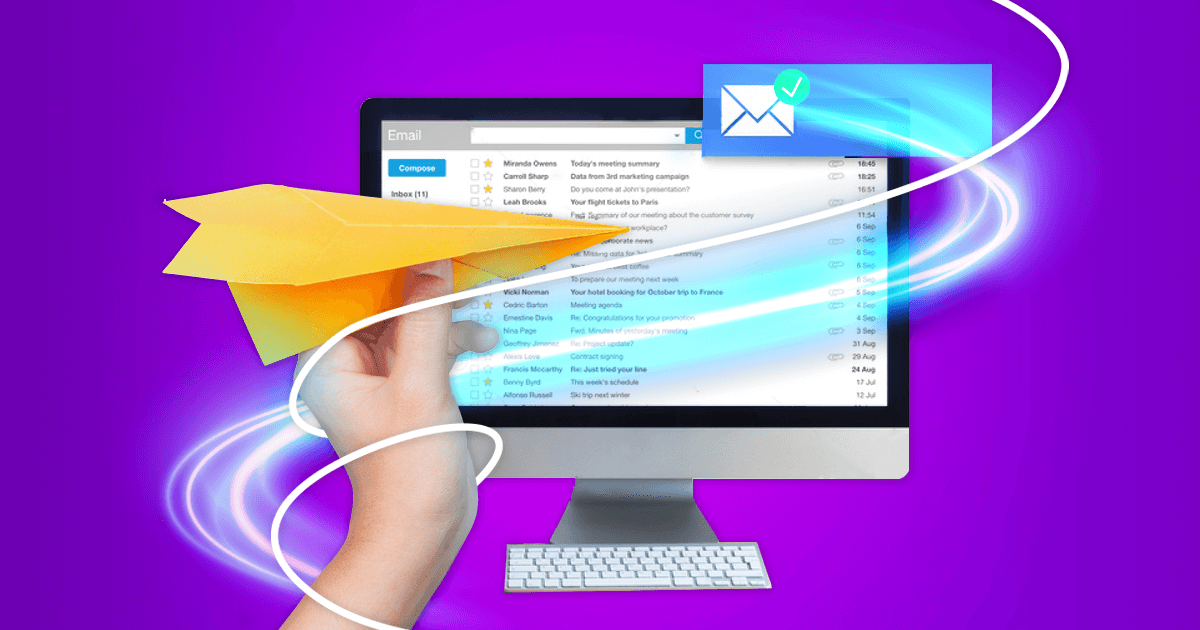Hello!
 Email marketing is useless if your messages do not reach your intended audience.
Email marketing is useless if your messages do not reach your intended audience.
Effective email campaigns can have a real impact on companies of all types, but only if the communications make it to a subscriber’s inbox. There’s nothing worse than crafting the perfect message only to have it never see the light of day. Deliverability is the most basic building block of any successful email marketing effort.
In addition to other key email analytics, deliverability rates should be evaluated regularly as a performance indicator, since they can impact future campaigns. While it may seem simple enough, there could be several factors preventing your messages from reaching your target audience.
What is email deliverability?
 Also known as”inbox positioning,” email deliverability suggests in which an email ends up when it reaches the receiver. The last destination could be in the primary inbox, a spam folder, an electronic garbage bin, or some designated area decided by the contact. Deliverability rates vary from shipping prices, which only indicate whether email bounces back to the sender.
Also known as”inbox positioning,” email deliverability suggests in which an email ends up when it reaches the receiver. The last destination could be in the primary inbox, a spam folder, an electronic garbage bin, or some designated area decided by the contact. Deliverability rates vary from shipping prices, which only indicate whether email bounces back to the sender.
2024 Deliverability Benchmark Report, One in 6 emails never make it into an inbox. That means for each six carefully intended messages, a promotion group curates and sends, an individual might not be delivered because of spam filtering.
This bothersome fact should inspire businesses to examine deliverability carefully, but what decides where an email lands in the first location?
What affects email deliverability?
There are three main points of consideration that dictate email deliverability rates:
Sender reputation
 Internet service providers (ISPs) utilize a sender reputation score assigned to each incoming email server to find out whether an email should make it into an inbox or whether it ought to be rejected. The sender rating can range anywhere from 0-100 and can be calculated by analyzing myriad metrics for example unsubscribes and spam accounts. A rating of 96 or over will almost always stop an ISP from approving the sender’s email as spam.
Internet service providers (ISPs) utilize a sender reputation score assigned to each incoming email server to find out whether an email should make it into an inbox or whether it ought to be rejected. The sender rating can range anywhere from 0-100 and can be calculated by analyzing myriad metrics for example unsubscribes and spam accounts. A rating of 96 or over will almost always stop an ISP from approving the sender’s email as spam.
Identification
In online lingo, identification describes the way ISPs authenticate email-sender info. It might incorporate the Sender Policy  Framework (SPF), which specifies the servers permitted to send email from a domain name; DomainKeys Identified Mail (DKIM), an email application using cryptographic technologies to confirm a domain name; or Domain-Based Message Authentication, Reporting, and Conformance (DMARC), a reporting protocol which shields domain owners from afar. Deploying some of the aforementioned tools can help lessen the danger of your emails being rejected.
Framework (SPF), which specifies the servers permitted to send email from a domain name; DomainKeys Identified Mail (DKIM), an email application using cryptographic technologies to confirm a domain name; or Domain-Based Message Authentication, Reporting, and Conformance (DMARC), a reporting protocol which shields domain owners from afar. Deploying some of the aforementioned tools can help lessen the danger of your emails being rejected.
Email content
If your communications seem and feel like spam, then they will almost definitely be considered such. Inadequate formatting, broken hyperlinks, and replicate containing dollar signs or a lot of exclamation points could be signals of a junk message, thus a round or two of conservative proofreading is essential before sending any email.
Also read:
- Which Treatment Is More Suitable For You: Physical Therapy Or Chiropractic?
- 4 Tips for Choosing the Right Accounting Software for Your Business
- How Proxies Boost Your Privacy and Protect Your Online Activities
What is a good email deliverability rate?
 Ideally, each email delivered would achieve its intended goal, but rebounds and rejections necessarily occur from time to time. Anyhow, a decent email deliverability speed is 95 percent or higher. Anything lower than that could indicate an alarm for promotion groups to research current approaches and pinpoint ways to improve email deliverability rates moving ahead.
Ideally, each email delivered would achieve its intended goal, but rebounds and rejections necessarily occur from time to time. Anyhow, a decent email deliverability speed is 95 percent or higher. Anything lower than that could indicate an alarm for promotion groups to research current approaches and pinpoint ways to improve email deliverability rates moving ahead.
How to improve your email deliverability
If you’re finding your email deliverability to be less than stellar, consider using some of the following strategies:
1. Start small
 Building up the standing of your internet protocol (IP) address is a significant thing to shield against deliverability problems, and analyzing the oceans is one fantastic place to start. Start efforts by sending little batches of emails to your engaged readers first, and gradually increase the quantity. Segmenting contact lists by receptive and click-through rates will help streamline the procedure.
Building up the standing of your internet protocol (IP) address is a significant thing to shield against deliverability problems, and analyzing the oceans is one fantastic place to start. Start efforts by sending little batches of emails to your engaged readers first, and gradually increase the quantity. Segmenting contact lists by receptive and click-through rates will help streamline the procedure.
By reaching an audience that has already shown they both take and love your communications, you will gradually get confidence with ISPs. This is an easy yet efficient approach to improve email deliverability organically over time.
2. Scrub your contact list regularly
 Maintaining a strong email listing (and checking it frequently) is an essential portion of deliverability achievement. Contact info is expected to change over time, so frequently removing inactive or suspicious readers routinely is critical. Eliminate contacts who haven’t opened or clicked in your communications in several months.
Maintaining a strong email listing (and checking it frequently) is an essential portion of deliverability achievement. Contact info is expected to change over time, so frequently removing inactive or suspicious readers routinely is critical. Eliminate contacts who haven’t opened or clicked in your communications in several months.
Recall bounce prices play a part in the way ISPs judge an incoming email address, therefore removing any email addresses which have shipped back difficult bounces is well worth time and energy. A decent bounce rate is about 2.5percent — anything greater than that could negatively influence sender reputation scores.
3. Know your numbers
Talking of sender scores, it is a great idea to keep tabs on where your IP drops upon the scale to improve email deliverability. These scores can fluctuate slightly based upon the ISP since they examine information sporadically and can vary over time-based on reconciling variables. As stated previously, a score of 95 percent or higher is perfect and will normally avoid spam flags.
 Businesses can locate their scores for free with ReturnPath. The sender reputation score is among the greatest reasons why ISPs reject mails, meaning advertising teams are going to want to execute regular checks to be sure they’re on the ideal path.
Businesses can locate their scores for free with ReturnPath. The sender reputation score is among the greatest reasons why ISPs reject mails, meaning advertising teams are going to want to execute regular checks to be sure they’re on the ideal path.
4. Don’t fall for spam traps
ISPs really like to grab junk mail aggressors from the action, and junk traps are among their preferred tactics to take action. A spam trap (occasionally known as a honeypot) is an email address made by an ISP especially supposed to flag spammers and prevent them in their tracks. They might be embedded in sites and accessed through scratching, look on contact lists, or come in the recycled speeches of previously active users.
To stop being caught in a junk trap, avoid purchasing email lists, and also confirm the proper spelling of addresses on your listing (typos are frequently an indicator of a trap).
5. Choose your “from” name carefully
 Personalizing emails is a simple yet powerful approach to boost participation and decrease spam complaints in precisely the same moment. Putting your brand alongside a first name at the “from” line of an email (by way of instance, “Rachelle out of BDC,” instead of “data” or”advertising”) provides a personal touch that is very likely to resonate with the contributor.
Personalizing emails is a simple yet powerful approach to boost participation and decrease spam complaints in precisely the same moment. Putting your brand alongside a first name at the “from” line of an email (by way of instance, “Rachelle out of BDC,” instead of “data” or”advertising”) provides a personal touch that is very likely to resonate with the contributor.
Adding the contact’s first name in the topic line has also been demonstrated to increase open rates, therefore look at deploying both customization approaches to enhance your chances of clicks. Engage with your mails, and expand a friendly tone certain to impress.
6. Double your opt-ins
Inviting site visitors to opt into emails is excellent for creating a subscriber base, but going the extra mile out of the start will pay off dividends through greater deliverability rates with time. A double opt-in necessitates the contact to confirm their choice to get your organization’s communications using a confirmation email.
Deploying a dual opt-in will help to ensure a submitted speech is really receiving email and expecting to participate further, a win-win for any advertising group.
7. Schedule campaigns consistently
Careful email campaign preparation is crucial for many different factors. Sending regular advertising emails (without being too intrusive) will help keep relationships with your viewers whilst at the same time helping prevent ISP rejection. Erratic email scheduling is seen as questionable and might result in spam coverage from readers who neglect what they chose.
 Consider sending one email every week and examine the analytics to inform future approaches. Communication once a month ought to be regarded as the minimum to maintain readers engaged.
Consider sending one email every week and examine the analytics to inform future approaches. Communication once a month ought to be regarded as the minimum to maintain readers engaged.
8. Explore feedback loops and blacklists just in case
If you’ve exhausted all of the tricks on this list and you’re still struggling to improve your email deliverability rate, you may want to check if your IP has been reported for bad behavior. Complaint feedback loops (FBLs) are gathered by ISPs and contain information about email recipients who have complained about the sender’s communications. Deploying an FBL provides insight into which campaigns are especially problematic for marketers.
DNS-based blacklists contain IPs that have received a large number of spam reports. ISPs scour these blacklists, automatically rejecting emails from domains named. Companies should avoid being blacklisted at all costs since the process of removal is extremely time-consuming and complicated.
Thank you!
Subscribe to our newsletter! Join us on social networks!
See you!






